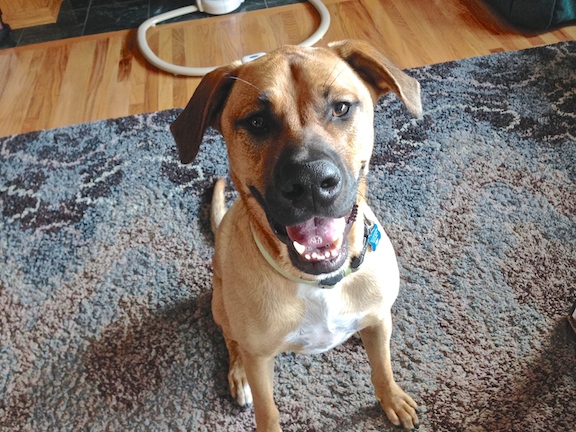Helping Indie Get Over His Territorial Aggression
By: David Codr
Published Date: August 7, 2014
 Indie is a one and a half year old Boxer Lab mix who gets territorially aggressive with strangers.
Indie is a one and a half year old Boxer Lab mix who gets territorially aggressive with strangers.
When I arrived for the session he was barking, but it was more an alerting style of bark. The thing is, Indie is a BIG dog. The photo really doesn’t do him justice. It wouldn’t surprise me at all if his bark and size would elicit a reaction from a guest. Because some dogs actually ramp up their aggression when they sense fear, the potential is there for things to go the wrong way, even with a dog who isn’t truly aggressive.
Once I got inside, Indie stopped barking, but he didn’t show much respect for my bag or personal space; walking where he wanted and sniffing in a somewhat aggressive way.
When I stood up to define my personal space, Indie walked away but circled back to try to get at my bag. I used a hissing sound which stopped Indie’s deep sniffing of my bag. Once he looked up from the bag, I walked towards him to get him to leave the bag alone.
I went over the set of escalating consequences I like to use when disagreeing with a dog or behavior. The first consequence is really more of an auditory warning, a hissing sound. I like to use that over the word no because Cats, raccoons, possums and other animals make a hissing sound as a warning. Because dogs instinctively recognize the sound as a warning, its usually much more effective than a “no!”
After I corrected him, Indie had moved over to sit down next to one of his owners. But he was leaning against him, showing no respect for his personal space. I had his owner use the hissing sound when Indie tried to get even closer. The hiss stopped Indie for a moment, but he didn’t move away. I told his owner to use the second consequence; standing up and facing the dog.
As soon as Indie’s owner stood up, the dog immediately got up and backed a few feet away. I had his owner remain in that position, then move back to his seated position while keeping his body turned to face the dog.
To a dog, standing up tall and facing the dog is a very commanding or authoritative position. By standing up to Indie when he got too close, his owner can communicate that he wants Indie to give him a little space. He had to repeat the process a number of times at first as did his other owner, but Indie clearly took note of them when they assumed a standing position.
Did I mention that Indie is a persistent dog? After a momentary pause, Indie resumed invading his owner’s personal space, so I had them use the third of the escalating consequences, marching right at the dog. As soon as his owner started in his direction, Indie immediately backed up and moved about 10 feet away.
After pausing for a second, Indie circled back around and sat a foot or two away from his owner instead of leaning up against him. It will take a few days of consistent applications of these escalating consequences before Indie starts to respect their boundaries of personal space on his own.
Indie responding to his owners when they use these new methods of communication is an easy way to practice disagreeing with unwanted behavior. Simply put, the more practice Indie has at obeying them when they disagree, the easier it will be to get him to stop all actions or behaviors.
This will help condition Indie to think of himself as having less social status or authority than the humans he lives with. Once this mindset is in place, they will be able to disagree with Indie when he gets territorially aggressive. Usually other treatments are required for dogs with territorial aggression, but Indie case is very mild and should be easy to abate with the right communication and a little practice.
Categorized in: Dog Behavior, Dog Psychology, Dog trainer in omaha, Dog trainer Nebraska, Dog Training Omaha, Nebraska dog training, Omaha dog training



